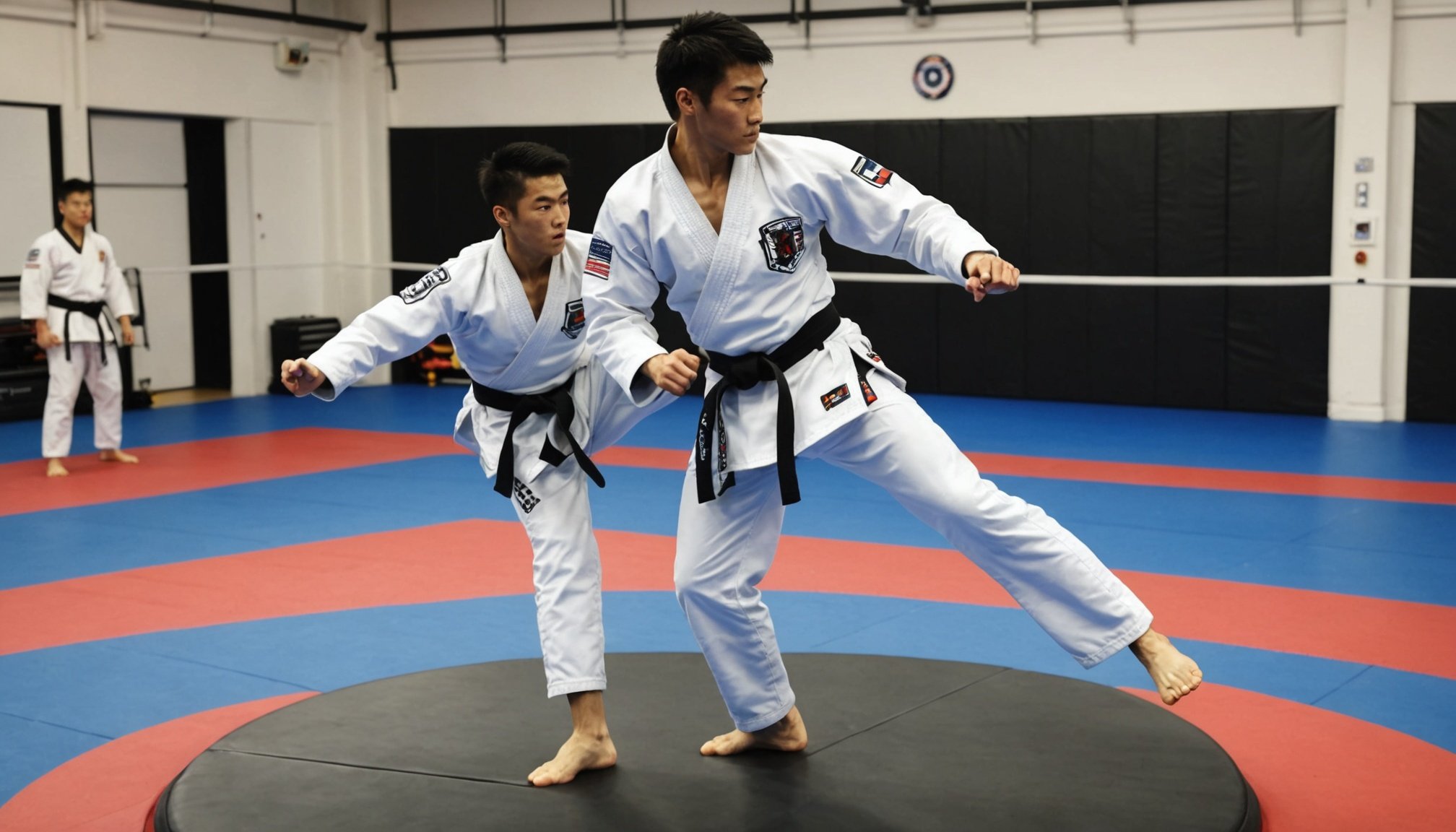Mastering Spinning Kicks: Effective Drills for UK Taekwondo Athletes to Elevate Performance
Understanding the Basics of Spinning Kicks in Taekwondo
Spinning kicks, or chagi in Korean, are a cornerstone of taekwondo, requiring a blend of technique, power, and flexibility. For UK taekwondo athletes aiming to elevate their performance, mastering these kicks is essential. Here’s a deep dive into the world of spinning kicks, including the different types, training methods, and practical tips.
Types of Spinning Kicks
Taekwondo features several types of spinning kicks, each with its unique characteristics and challenges:
In parallel : Unlocking Tactical Mastery: Strategies Used by UK Judo Competitors to Elevate Their Game
- Huryeo Chagi (Turning Kick): This is one of the most common spinning kicks. It involves rotating the body while keeping the kicking leg straight, aiming to strike with the ball of the foot.
- Bandal Chagi (Hook Kick): This kick involves a hooking motion with the foot, often targeting the head or body. It requires precise timing and control.
- Dwi Chagi (Back Kick): Executed by spinning and kicking backwards, this kick is particularly effective in sparring situations where opponents are closing in.
- Bituro Chagi (Twisting Kick): A variation of the turning kick, this involves twisting the body to generate additional power.
Training Drills for Spinning Kicks
Effective training is key to mastering spinning kicks. Here are some drills and techniques that UK taekwondo athletes can incorporate into their practice:
Warm-Up and Flexibility Exercises
Before diving into kicking drills, a thorough warm-up and flexibility exercises are crucial. This includes:
This might interest you : Building Mental Toughness: Strategies to Enhance Resilience in Young Combat Sports Athletes in the UK
- Dynamic Stretching: Leg swings, hip circles, and torso twists to prepare the muscles.
- Static Stretching: Focusing on the hamstrings, quadriceps, and hip flexors to improve flexibility.
Basic Kicking Technique
- Stance and Balance: Start with a stable stance, ensuring balance is maintained throughout the kick.
- Chamber Position: Bring the kicking leg to the chamber position (bent at a 90-degree angle) before executing the kick.
- Rotation and Extension: Rotate the body and extend the kicking leg, focusing on the target.
Drills for Beginners
For athletes at the beginner level, here are some drills to get started:
- Kicking Pads: Practice kicking pads held by a partner to improve accuracy and timing.
- Kicking Bags: Use heavy bags to build power and endurance.
- Mirror Work: Practice kicks in front of a mirror to correct form and technique.
Detailed Drill List for Beginners:
- Drill 1: Stationary Kicking
- Stand in a stable stance.
- Chamber the kicking leg.
- Execute a slow and controlled kick.
- Repeat on both sides.
- Drill 2: Moving Kicking
- Move forward or backward while executing the kick.
- Focus on maintaining balance.
- Drill 3: Partner Drills
- Have a partner hold a pad or bag.
- Practice kicking while moving around the partner.
Intermediate Level Training
As athletes progress to the intermediate level, the drills become more complex and demanding.
Intermediate Drills
- Spinning Kick Combinations: Practice combinations of spinning kicks, such as huryeo chagi followed by a bandal chagi.
- Poomse Integration: Incorporate spinning kicks into poomse (forms) practice to improve technique in a more dynamic setting.
- Sparring Drills: Practice spinning kicks in controlled sparring scenarios to develop timing and reaction.
Table: Comparison of Drills at Different Levels
| Drill Type | Beginner Level | Intermediate Level | Advanced Level |
|---|---|---|---|
| Kicking Pads | Focus on basic technique | Increase speed and power | Add combinations and variations |
| Kicking Bags | Build basic power and endurance | Increase intensity and duration | Incorporate different kicking styles |
| Mirror Work | Correct form and technique | Focus on fluid movement | Analyze and refine advanced techniques |
| Spinning Combinations | Not applicable | Practice basic combinations | Complex combinations and transitions |
| Poomse Integration | Not applicable | Basic integration | Advanced integration with other techniques |
| Sparring Drills | Not applicable | Controlled sparring scenarios | Dynamic and unpredictable scenarios |
Advanced Level Training
For athletes at the advanced level, the focus shifts to refining techniques, increasing complexity, and enhancing performance in real-world scenarios.
Advanced Drills
- Complex Combinations: Practice intricate combinations of spinning kicks, such as huryeo chagi followed by a dwi chagi.
- Dynamic Sparring: Engage in sparring with varying levels of intensity and unpredictability.
- Conditioning and Strength Training: Incorporate strength and conditioning exercises to enhance power and endurance.
Quote from Master Instructors:
“Spinning kicks are not just about technique; they are about timing, power, and control. Advanced athletes need to focus on integrating these kicks seamlessly into their sparring and forms practice.” – Master Kim, UK Taekwondo Federation.
Additional Tips and Information
Foot Care and Injury Prevention
- Proper Footwear: Use appropriate footwear during training to prevent injuries.
- Warm-Up and Cool-Down: Always warm up thoroughly before training and cool down afterwards to prevent muscle strain.
- Stretching and Foam Rolling: Regular stretching and foam rolling can help maintain flexibility and reduce muscle soreness.
Mental Preparation
- Focus and Concentration: Practice mindfulness and meditation to improve focus and concentration during training.
- Positive Self-Talk: Use positive affirmations to boost confidence and performance.
Using Boards and Pads
- Breaking Boards: Practice breaking boards to build power and precision.
- Kicking Pads: Use kicking pads to improve accuracy and timing.
Detailed List of Additional Information:
- Image Additional Information:
- Click on images of different kicking techniques to get a visual understanding.
- Analyze the chamber position, rotation, and extension of the kick.
- Answer Gave:
- Q: How often should I practice spinning kicks?
- A: Aim to practice spinning kicks at least 2-3 times a week, with a focus on technique and power.
- Q: What is the best way to improve my flexibility for spinning kicks?
- A: Regular stretching, foam rolling, and dynamic warm-ups can significantly improve flexibility.
Mastering spinning kicks in taekwondo is a journey that requires dedication, practice, and a deep understanding of the techniques involved. By following the drills and tips outlined above, UK taekwondo athletes can elevate their performance, whether they are at the beginner, intermediate, or advanced level. Remember, practice is key, and continuous improvement is the path to mastery.
In the words of Grandmaster Lee, “Taekwondo is not just a martial art; it is a way of life. Mastering spinning kicks is part of that journey, and with persistence and the right training, anyone can achieve excellence.”











